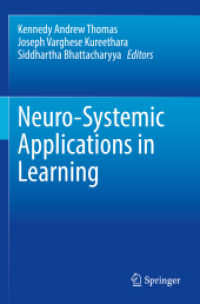- ホーム
- > 洋書
- > ドイツ書
- > Mathematics, Sciences & Technology
- > Technology
- > construction & environment engineering
Full Description
This book presents fundamental principles and recent advancements in managing waste in an environmentally sustainable manner. It explores a wide array of methods and technologies designed to transform waste, thereby reducing health impacts across various stages such as waste minimization, transportation, handling, storage, and disposal of solid wastes. Moreover, the book delves into waste-contaminated site assessment methods, environmental issues and impacts, as well as the latest regulatory and policy statutes. The inclusion of case studies allows for the assessment of diverse waste management challenges, showcasing how environmental engineering methods can be applied to process industrial waste sustainably. For instance, certain sections of the book delve into the intricate microbial communities and their metabolic pathways, illustrating their role in the remediation and management of municipal waste at landfill sites. This book caters to a broad audience, including teachers, researchers, practitioners, environmental engineers, chemical engineers, soil scientists, policymakers, and students specializing in environmental engineering, chemical engineering, environmental biotechnology, and environmental science.
Contents
Part I Waste and Impact.- Chapter 1 Emerging contaminants of tannery sludge and their environmental impact and health hazards.- Chapter 2 Municipal solid waste collection, transportation, and segregation.- Chapter 3 Industrial wastewater sludge management.- Part II Waste Recycling, Reuse, and Resource Recovery.- Chapter 4 Sewage sludge.- Chapter 5 Sustainable solutions.- Chapter 6 Construction and demolition waste management.- Chapter 7 Approaches involved in the treatment and disposal of petroleum refinery sludge.- Chapter 8 Waste Management in COVID-19 Pandemic.- Chapter 9 Circular cement decarbonization.- Chapter 10 Novel approaches for greener synthesis of extremozymes using agro/food waste.- Chapter 11 Microplastic waste management in textile industry wastewater.- Chapter 12 Agri-food waste management and treatment approaches for environmental sustainability.- Part III Environmental Technologies.- Chapter 13 Landfill Biomining of legacy waste dumpsites in India.- Chapter 14 Harnessing microbial recycling of organic wastes in a circular waste management system for greenhouse gas reduction.- Chapter 15 Profiling of microbial community and their role in solid waste treatment.- Chapter 16 Composting and vermitechnology in organic waste management.- Chapter 17 Advancing phytoremediation from lab research to field applications.- Chapter 18 Advancements in biomass degradation.- Part IV Recent Trends and Development.- Chapter 20 Integrated environmental technologies for waste management.- Chapter 21 Integrated physicochemical and biological treatment processes and resource recovery as futuristic approach for management of paper and pulp industry effluent. Chapter 22 Circular waste management system and green house gases reduction.- Chapter 23 Industry 4.0.- Chapter 24 Life cycle and cost estimation of solid waste management practices.






